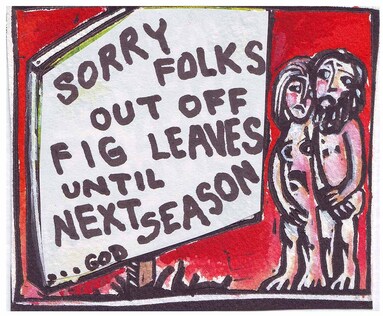 Cartoon by Natasha Williams-Novak
Cartoon by Natasha Williams-Novak By Linda Gordon
FIGS are ingenious and highly successful trees. Did you know that there are 750 known species; more than either the eucalyptus or oaks?
FIGS are ingenious and highly successful trees. Did you know that there are 750 known species; more than either the eucalyptus or oaks?
“Extraordinarily - indeed it all starts to seem miraculous – each kind of fig has its own species of symbiotic wasp. Each wasp co-evolved with the fig it pollinates. “
These remarkable fig facts and much, much more are revealed in The Secret Life of Trees, How They Live and Why They Matter by zoologist, philosopher and writer Colin Tudge.
If you read this detailed book (you’ll need to set aside some time), it’s quite possible you will never again walk past a tree without feeling something like awe, reverence and deep gratitude.
Back to the fantastic fig. “There is nothing quite like a human being. And there is nothing, absolutely nothing, like a fig”, says Tudge.
The fruit of the fig is actually a fleshy cup, or “syconia”, almost completely sealed at the top and containing hundreds of inward flowers. Female fig wasps slip through the tiny hole at the top of the cup intent on colonizing and procreation. Each time she does this she creates a new generation of wasps, and is known as a ‘foundress’. The fruit is both womb and tomb for the female wasp. “After she has laid her eggs, she dies. The fruit becomes her sepulchre.”
It is nicely operatic but gets better. The wasp’s eggs hatch, feed on the flower seeds, pupate and emerge as adults.
Most of the new brood are females. “The males are wingless. They emerge before the females, chewing their way out of their respective seeds. Then they chew their way into seeds containing females, and mate with them while the females are still inside.”
Then the male wasps die. Birth, death, decay, sex ... all this primeval action inside a bit of fruit!
Finally, “The newly-emerged females, already with sperm on board, now fossick around inside the syconium (fruit), picking up pollen from the male flowers ... then they fly off to found a new generation in a new syconium. These young females are laden with pollen and so they fertilize the flowers of the next syconium.”
Fig wasps can fly enormous distances, in some parts carried with the wind hundreds of kilometres from their starting point. Figs and their wasps enjoy a “wonderful mutualism”. And this intimate relationship is tens of millions of years old.
It’s a complicated story and I have hardly done it justice. But one thing’s for sure; the two baby fig trees, newly planted in our version of the Garden of Eden in Wonthaggi, are in for some interesting times.
These remarkable fig facts and much, much more are revealed in The Secret Life of Trees, How They Live and Why They Matter by zoologist, philosopher and writer Colin Tudge.
If you read this detailed book (you’ll need to set aside some time), it’s quite possible you will never again walk past a tree without feeling something like awe, reverence and deep gratitude.
Back to the fantastic fig. “There is nothing quite like a human being. And there is nothing, absolutely nothing, like a fig”, says Tudge.
The fruit of the fig is actually a fleshy cup, or “syconia”, almost completely sealed at the top and containing hundreds of inward flowers. Female fig wasps slip through the tiny hole at the top of the cup intent on colonizing and procreation. Each time she does this she creates a new generation of wasps, and is known as a ‘foundress’. The fruit is both womb and tomb for the female wasp. “After she has laid her eggs, she dies. The fruit becomes her sepulchre.”
It is nicely operatic but gets better. The wasp’s eggs hatch, feed on the flower seeds, pupate and emerge as adults.
Most of the new brood are females. “The males are wingless. They emerge before the females, chewing their way out of their respective seeds. Then they chew their way into seeds containing females, and mate with them while the females are still inside.”
Then the male wasps die. Birth, death, decay, sex ... all this primeval action inside a bit of fruit!
Finally, “The newly-emerged females, already with sperm on board, now fossick around inside the syconium (fruit), picking up pollen from the male flowers ... then they fly off to found a new generation in a new syconium. These young females are laden with pollen and so they fertilize the flowers of the next syconium.”
Fig wasps can fly enormous distances, in some parts carried with the wind hundreds of kilometres from their starting point. Figs and their wasps enjoy a “wonderful mutualism”. And this intimate relationship is tens of millions of years old.
It’s a complicated story and I have hardly done it justice. But one thing’s for sure; the two baby fig trees, newly planted in our version of the Garden of Eden in Wonthaggi, are in for some interesting times.